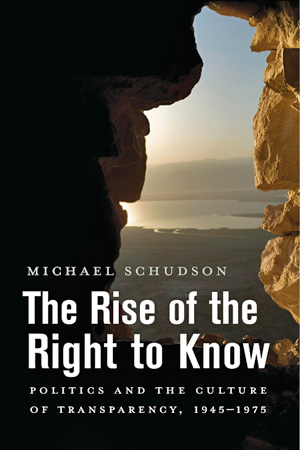
This book examines the history of a set of transparency-related reforms that came to fruition in the 1960s and 1970s. The term “transparency” was not in general use in politics then, and these reforms were not linked to one another. It is only in retrospect that the Freedom of Information Act, legislation to reduce secret voting in the Congress, new practices in consumer information, and the legal invention of public environmental impact statements in 1970 all look like first cousins.
All of these developments made U.S. society more transparent. But they were promoted by different people, for different reasons, and with different rhetorics. There was consumer information reform, which instituted unit pricing in supermarkets and required expiration dates on perishable food items and nutritional labeling, and President Kennedy mentioned a “consumer’s right to be informed” in a 1962 message to Congress, but no such language marked the “environmental impact statement” innovation. Efforts to make more votes in Congress public were promoted as “anti-secrecy” measures but without reference to citizens’ “rights.”
Even the 1966 Freedom of Information Act acquired its noble name after it became law, not in the effort to pass it; it had been dubbed simply the “federal public records act” and passed as an amendment to the Administrative Procedures Act of 1946. While proponents of the act noted the importance of informed citizens in a democracy, the legislators did not do much to address the public or to encourage public support for their proposal. The whole business was regarded largely as a way for the Congress to hold the executive branch accountable.
The various efforts to pass transparency-enhancing laws that came into effect in 1966, 1968, 1970, and 1971 were not products of the cultural “sixties.” The primary sponsors were World War II veterans. They were seasoned legislators with political careers dating back to the 1940s. All contributed to “the rise of the right to know” without ever having meant to do so. Transparency for them was a means to some other ends.
This book has a specific origin in a book I published in 1998. In The Good Citizen: A History of American Civic Life, I argued that the character of American civic life cannot be measured on a single dimension in which we become better or worse citizens with a better or worse civic life. Instead, the very concept of a good citizen changed – at least three times in the course of U.S. history. I presented this account as a critique of some influential thinkers who understood American civic life to be in sharp decline from a better era – the era of the 1950s.
I took particular aim at the work of Robert Putnam in his brilliant – but I think deeply mistaken – Bowling Alone (1995). Surely, I thought, and contrary to Putnam, American civic life, on balance, is better in the 1990s or 2000s than in the 1950s! Obviously, it is more inclusive now than it was then. Neither women nor African-Americans nor gays and lesbians can have much nostalgia for the 1950s. But beyond that obvious point, some other things have improved enormously, and one of those things is that transparency has become a more widely shared value. These days, doctors tell their patients with cancer that they have cancer; in the 1950s, that was rare. In the 1950s, the doctor-patient relationship was highly paternalistic, and this went largely unquestioned. Medical research did not seek the informed consent of people that research physicians enrolled in experiments. Members of Congress routinely hid their voting from public view. Are we not, on balance, much better off now that individuals’ autonomy in making decisions about their own lives is much more recognized and honored than it was in the 1950s?
But, I wondered, how much changed and how did it change? This book takes transparency in a wide variety of conditions, including government transparency, to be a valuable part of a high-quality civic life and to have clearly improved in the post-1950s era. But what, I wondered, is the history of the shift to greater transparency? No one had really tackled that topic as a whole. My aim was to make a good start on the project.
I think the most interesting and surprising chapter in the book is the one on the role of public disclosure in environmental legislation. What is detailed, especially on pp. 205-219, indicates that the key sponsors of the key law, the 1970 National Environmental Policy Act, were interested exclusively in improving environmental protection, not in transparency of any sort. The key provision of the law was the requirement that any federal agency proposing actions that might have adverse effects on the environment must produce a report assessing the environmental impact that the proposed action might have, how likely the bad effects could be, and what measures, if any, could mitigate the harm.
Most important, these environmental impact statements had to be issued before agencies began to execute their proposed plans. They had to be made public in a timely matter. Private citizens and interest groups could then make their voices heard in the halls of executive agencies.
Part of what is so fascinating to me about this is that the provision in the law that environmental impact assessments be made public – rather than just shared among government agencies as the bill’s sponsors originally proposed – seems to have been an afterthought. And, indeed, not until early judicial interpretations of the law began to appear, a year after the law took effect, did Congress realize that the publicness of the whole procedure would give rise to lawsuits – lots of them! – against the government on behalf of the environment. Transparency profoundly transformed the battlefield over environmental protection, and at a moment when general public interest in environmental issues was just beginning to develop.
I wish for this book to help people see that even some of the things we have come to take for granted in our own everyday lives, things that seem to us practices of obvious value, were not obvious to most people but emerged in the imaginations of reformers. Today some of the practices the reformers changed sound unbelievable: that the House of Representatives voted secretly on major amendments to major legislation until 1970? That milk, cottage cheese, and eggs at the supermarket until about the same time had “sell-by” dates stamped on them – but stamped in code so that store employees but not consumers could read them? That doctors until about the same time avoided telling their patients with cancer that they had cancer? Times have changed!
I’m not a political scientist and I’m not a specialist in the study of Congress, so examining the inner life of a handful of legislative acts and the people in and out of the Congress who shaped them was revelatory to me. And I think the fact that I knew so little and learned so much in doing the research for this book helps the book to preserve the sense of drama that these legislative efforts had at the time, and the sense of how much new legislation can be a step into the unknown, with no one sure just where it might lead. Those who supported the Freedom of Information Act had no clue that corporations would be the primary users of “FOIA.” Those who supported the environmental impact statement had no clue that it would generate hundreds of lawsuits against the government for inadequate environmental protections and half-baked impact assessments.
And no one in 1970 saw coming – and coming fairly soon down the road – that “transparency” would become a magic word in American political culture, seen as a solution, or a half-solution, or a sop when more substantive efforts at reform seemed impossible.


Michael Schudson grew up in Milwaukee, Wisconsin, received his B.A. from Swarthmore College in 1969 and Ph.D. in sociology from Harvard in 1976. His first book, Discovering the News: A Social History of American Newspapers (1978), explains how “objectivity” came to be the central value for journalists in the U.S. Later books examined the role of advertising in American society, how “Watergate” became part of U.S. collective memory, a study of changing concepts in American history of what a “good citizen” should be, and three books of essays on American journalism. Schudson taught at the University of California, San Diego, 1981-2009, and has taught at Columbia Journalism School since 2009. His honors include a MacArthur “genius” fellowship, a Guggenheim Fellowship, and membership in the American Academy of Arts and Sciences.